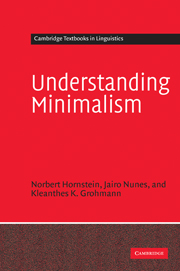Book contents
- Frontmatter
- Contents
- Preface
- List of abbreviations
- 1 The minimalist project
- 2 Some architectural issues in a minimalist setting
- 3 Theta domains
- 4 Case domains
- 5 Movement and minimality effects
- 6 Phrase structure
- 7 Linearization
- 8 Binding Theory
- 9 Feature interpretability and feature checking
- 10 Derivational economy
- Glossary of minimalist definitions
- References
- Language index
- Name index
- Subject index
4 - Case domains
Published online by Cambridge University Press: 05 June 2012
- Frontmatter
- Contents
- Preface
- List of abbreviations
- 1 The minimalist project
- 2 Some architectural issues in a minimalist setting
- 3 Theta domains
- 4 Case domains
- 5 Movement and minimality effects
- 6 Phrase structure
- 7 Linearization
- 8 Binding Theory
- 9 Feature interpretability and feature checking
- 10 Derivational economy
- Glossary of minimalist definitions
- References
- Language index
- Name index
- Subject index
Summary
Introduction
As we saw in section 2.3.1.1, one of the substantive principles that defines S-Structure as a syntactic level of representation within GB is the Case Filter. The idea that Case Theory should apply at SS is based on (i) the empirical fact that DPs may have different phonetic shape depending on the type of Case they bear, as illustrated in (1) below; (ii) empirical contrasts such as the one in (2), which indicates that the chain CH = (OPi, ti) must have Case at LF (presumably to satisfy the Visibility Condition) despite its lack of phonetic content; and (iii) the technical assumption that DPs are not inherently specified with respect to Case at DS.
(1) [IP heNOM [I′ I0 [vP t admires himACC]]]
(2) a. I met the man [OPi that Mary believed ti to be a genius]
b. *I met the man [OPi that it was believed ti to be a genius]
If DPs acquire Case-specification after DS but before they are shipped to the PF and LF components, it makes sense to take SS as the appropriate level to filter out Caseless DPs. Under this view, the subject pronoun in (1), for example, satisfies the Case Filter at SS after moving from its base position to [Spec,IP] and receiving nominative Case from I0; thus, it complies with the Visibility Condition at LF and is phonetically realized as he, and not as him or his.
- Type
- Chapter
- Information
- Understanding Minimalism , pp. 111 - 140Publisher: Cambridge University PressPrint publication year: 2005



